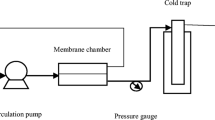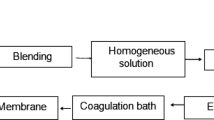Abstract
Membrane separation is an attractive technique for removal of emulsified oily wastewater. However, polymeric membranes which dominate the current market usually suffer from severe membrane fouling. Therefore, membranes with high fouling resistance are imperative to treat emulsified oily wastewater. In this study, carbon nanotube-polyvinyl alcohol (CNT-PVA) membrane was fabricated. And its separation performance for emulsified oily wastewater was compared with two commercial polymeric membranes (PVDF membrane and PES membrane) by filtration of two homemade emulsions and one cutting fluid emulsion. The results show that these membranes have similar oil retention efficiencies for the three emulsions. Whereas, the permeation flux of CNT-PVA membrane is 1.60 to 3.09 times of PVDF membrane and 1.41 to 11.4 times of PES membrane, respectively. Moreover, after five consecutive operation circles of filtration process and back flush, CNT-PVA membrane can recover 62.3% to 72.9% of its initial pure water flux. However, the pure water flux recovery rates are only 24.1% to 35.3% for PVDF membrane and 6.0% to 26.3% for PES membrane, respectively. Therefore, CNT-PVA membrane are more resistant to oil fouling compared with the two polymeric membranes, showing superior potential in treatment of emulsified oily wastewater.

Similar content being viewed by others

References
Chakrabarty B, Ghoshal A K, Purkait M K (2008). Ultrafiltration of stable oil-in-water emulsion by polysulfone membrane. Journal of Membrane Science, 325(1): 427–437
Chakrabarty B, Ghoshal A K, Purkait M K (2010). Cross-flow ultrafiltration of stable oil-in-water emulsion using polysulfone membranes. Chemical Engineering Journal, 165(2): 447–456
Chen W, Peng J, Su Y, Zheng L, Wang L, Jiang Z (2009). Separation of oil/water emulsion using Pluronic F127 modified polyethersulfone ultrafiltration membranes. Separation and Purification Technology, 66(3): 591–597
Coca J, GutiÉRrez G, Benito J (2011). Treatment Of Oily Wastewater. In: Water Purification and Management. Dordrecht: Springer
Cui J, Zhang X, Liu H, Liu S, Yeung K L (2008). Preparation and application of zeolite/ceramic microfiltration membranes for treatment of oil contaminated water. Journal of Membrane Science, 325 (1): 420–426
Dumee L, Velleman L, Sears K, Hill M, Schutz J, Finn N, Duke M, Gray S (2010). Control of porosity and pore size of metal reinforced carbon nanotube membranes. Membranes (Basel), 1(1): 25–36
Dumée L F, Sears K, Schütz J, Finn N, Huynh C, Hawkins S, Duke M, Gray S (2010). Characterization and evaluation of carbon nanotube Bucky-Paper membranes for direct contact membrane distillation. Journal of Membrane Science, 351(1–2): 36–43
Fan X, Zhao H, Liu Y, Quan X, Yu H, Chen S (2015). Enhanced permeability, selectivity, and antifouling ability of CNTs/Al2O3 membrane under electrochemical assistance. Environmental Science & Technology, 49(4): 2293–2300
Hesampour M, Krzyzaniak A, Nyström M (2008). Treatment of waste water from metal working by ultrafiltration, considering the effects of operating conditions. Desalination, 222(1–3): 212–221
Hilal N, Busca G, Hankins N, Mohammad A W (2004). The use of ultrafiltration and nanofiltration membranes in the treatment of metalworking fluids. Desalination, 167: 227–238
Križan Milic J, Muric A, Petrinic I, Simonic M (2013). Recent developments in membrane treatment of spent cutting-oils: A review. Industrial & Engineering Chemistry Research, 52(23): 7603–7616
Li Y, He G, Wang S, Yu S, Pan F, Wu H, Jiang Z (2013). Recent advances in the fabrication of advanced composite membranes. Journal of Materials Chemistry. A, Materials for Energy and Sustainability, 1(35): 10058
Liu D, Li D, Du D, Zhao X, Qin A, Li X, He C (2015). Antifouling PVDF membrane with hydrophilic surface of terry pile-like structure. Journal of Membrane Science, 493: 243–251
Lu D, Zhang T, Gutierrez L, Ma J, Croué J P (2016). Influence of surface properties of filtration-layer metal oxide on ceramic membrane fouling during ultrafiltration of oil/water emulsion. Environmental Science & Technology, 50(9): 4668–4674
Miyoshi T, Nguyen T P, Tsumuraya T, Tanaka H, Morita T, Itokawa H, Hashimoto T (2018). Energy reduction of a submerged membrane bioreactor using a polytetrafluoroethylene (PTFE) hollow-fiber membrane. Frontiers of Environmental Science & Engineering, 12 (3): 1
Muppalla R, Jewrajka S K, Reddy A V R (2015). Fouling resistant nanofiltration membranes for the separation of oil–water emulsion and micropollutants from water. Separation and Purification Technology, 143: 125–134
Padaki M, Surya Murali R, Abdullah M S, Misdan N, Moslehyani A, Kassim M A, Hilal N, Ismail A F (2015). Membrane technology enhancement in oil–water separation: A review. Desalination, 357: 197–207
Rao G, Brastad K S, Zhang Q, Robinson R, He Z, Li Y (2016). Enhanced disinfection of Escherichia coli and bacteriophage MS2 in water using a copper and silver loaded titanium dioxide nanowire membrane. Frontiers of Environmental Science & Engineering, 10 (4): 11
RashidMH O, Pham S Q T, Sweetman L J, Alcock L J, Wise A, Nghiem L D, Triani G, Panhuis M, Ralph S F (2014). Synthesis, properties, water and solute permeability of MWNT buckypapers. Journal of Membrane Science, 456: 175–184
Rho H, Chon K, Cho J (2018). Surface charge characterization of nanofiltration membranes by potentiometric titrations and electrophoresis: Functionality vs. zeta potential. Desalination, 427: 19–26
Sears K, Dumée L, Schütz J, She M, Huynh C, Hawkins S, Duke M, Gray S (2010). Recent developments in carbon nanotube membranes for water purification and gas separation. Materials (Basel), 3(1): 127–149
Van der Bruggen B, Mänttäri M, Nyström M (2008). Drawbacks of applying nanofiltration and how to avoid them: A review. Separation and Purification Technology, 63(2): 251–263
Wei G, Chen S, Fan X, Quan X, Yu H (2015). Carbon nanotube hollow fiber membranes: High-throughput fabrication, structural control and electrochemically improved selectivity. Journal of Membrane Science, 493: 97–105
Wei G, Yu H, Quan X, Chen S, Zhao H, Fan X (2014). Constructing all carbon nanotube hollow fiber membranes with improved performance in separation and antifouling for water treatment. Environmental Science & Technology, 48(14): 8062–8068
Yi G, Chen S, Quan X, Wei G, Fan X, Yu H (2018). Enhanced separation performance of carbon nanotube–polyvinyl alcohol composite membranes for emulsified oily wastewater treatment under electrical assistance. Separation and Purification Technology, 197: 107–115
Yi X S, Yu S L, ShiW X, Sun N, Jin L M, Wang S, Zhang B, Ma C, Sun L P (2011). The influence of important factors on ultrafiltration of oil/ water emulsion using PVDF membrane modified by nano-sized TiO2/Al2O3. Desalination, 281: 179–184
Zhang G, Jiang J, Zhang Q, Gao F, Zhan X, Chen F (2016). Ultralow oilfouling heterogeneous poly (ether sulfone) ultrafiltration membrane via blending with novel amphiphilic fluorinated gradient copolymers. Langmuir, 32(5): 1380–1388
Zhu Y, Wang D, Jiang L, Jin J (2014). Recent progress in developing advanced membranes for emulsified oil/water separation. NPG Asia Materials, 6(5): e101
Acknowledgements
This research was supported by the National Natural Science Foundation of China (Grant No. 21437001), the Programme of Introducing Talents of Discipline to Universities (B13012) and the Fundamental Research Funds for the Central Universities (DUT16TD02).
Author information
Authors and Affiliations
Corresponding author
Electronic supplementary material
Rights and permissions
About this article
Cite this article
Yi, G., Fan, X., Quan, X. et al. Comparison of CNT-PVA membrane and commercial polymeric membranes in treatment of emulsified oily wastewater. Front. Environ. Sci. Eng. 13, 23 (2019). https://doi.org/10.1007/s11783-019-1103-x
Received:
Revised:
Accepted:
Published:
DOI: https://doi.org/10.1007/s11783-019-1103-x



